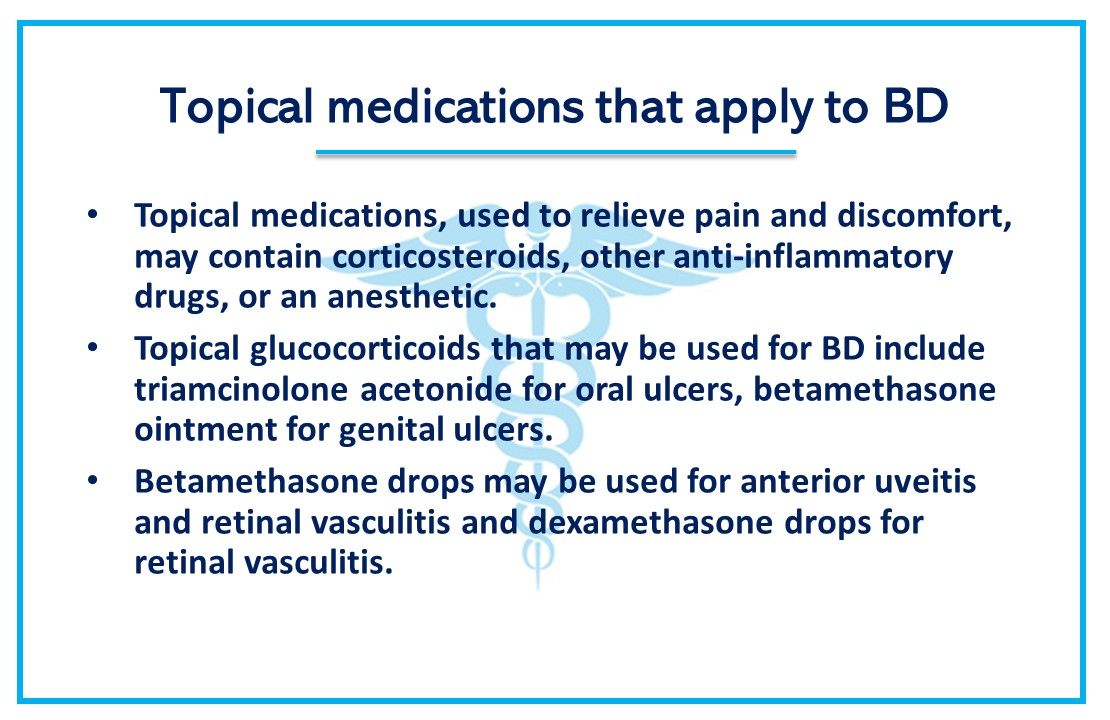Promising prognosis. The treatment goal for patients with BD is to reduce discomfort and prevent serious complications. Symptoms may be controlled with proper medication, a healthy diet, rest, and exercise. Treating disease manifestations according to disease severity is key. Flares usually become less frequent when treatment is effective, and patients may have periods of remission, though symptoms may re-occur and appear months or years after the diagnosis. Most patients can lead productive lives.
Diverse care team. Achieving optimal care for patients with BD may require a coordinated effort from amultidisciplinary team: rheumatologists (the main physicians involved), dermatologists, gynecologists, urologists, gastroenterologists, pulmonologists, otorhinolaryngologists, ophthalmologists, nephrologists, hematologists, neurologists, psychiatrists, dentists, pain management specialists—and internists and family practice physicians. Communication among the various physicians is essential.
First approved treatment for oral ulcers. The oral selective phosphodiesterase 4 inhibitor apremilast (Otezla) is the first and only FDA-approved treatment for oral ulcers associated with BD, the earliest manifestation of the disorder and the most common sign. Approval of apremilast as a 30 mg twice-daily therapy for adult patients in the United States was based on efficacy and safety results of a randomized, double-blind, placebo-controlled phase 3 RELIEF study.
Topical medications that apply to BD. Topical medications, applied directly to ulcers and skin lesions to relieve pain and discomfort, may contain corticosteroids, other anti-inflammatory drugs, or an anesthetic. Topical glucocorticoids that may be used for BD include triamcinolone acetonide for oral ulcers, betamethasone ointment for genital ulcers, betamethasone drops for anterior uveitis and retinal vasculitis, and dexamethasone drops for retinal vasculitis.
TNF Inhibitors may reduce BD symptoms. Most tumor necrosis factor (TNF) inhibitors—used for patients with rheumatoid arthritis, juvenile rheumatoid arthritis, psoriasis, psoriatic arthritis, ankylosing spondylitis, ulcerative colitis, Crohn disease, and other rheumatologic disorders—have not received FDA approval for BD. But they may help reduce BD symptoms. They include etanercept (Enbrel), infliximab (Remicade), adalimumab (Humira), certolizumab (Cimzia), and golimumab (Simponi).
Systemic glucocorticoids have anti-inflammatory effects. Systemic glucocorticoids sometimes are used in treating patients with BD. Prednisone may be used for GI lesions, acute meningoencephalitis, chronic CNS lesions, arthritis, erythema nodosum, anterior uveitis, and retinal vasculitis. Methylprednisolone may be used for GI lesions; acute meningoencephalitis; chronic, progressive CNS lesions; arteritis; retinal vasculitis; and venous thrombosis.
More agents in the mix. In addition to apremilast, other agents physicians may use for BD include methotrexate for arthritis, retinal vasculitis, and chronic CNS lesions and tetracycline for oral ulcers. Colchicine is used for arthritis, oral ulcers, genital ulcers, and erythema nodosum and thalidomide for oral and genital ulcers. Still other agents for BD include azathioprine, cyclosporine, cyclophosphamide, dapsone, pentoxifylline, sulfasalazine, aspirin, and MAGIC mouthwash.
Extra points. A lack of controlled studies limits certainty in treating patients with BD. Younger male patients are at greatest risk for severe disease, warranting expectant and aggressive treatment. Corticosteriods help suppress inflammation in acute phases of the disease but do not consistently suppress mucosal ulcers or CNS disease.
___________________________________________________
For highlights of the American Behçet Disease Association's discussion of BD diagnosis, please see “Behçet Basics for Primary Care: Diagnosis.”









